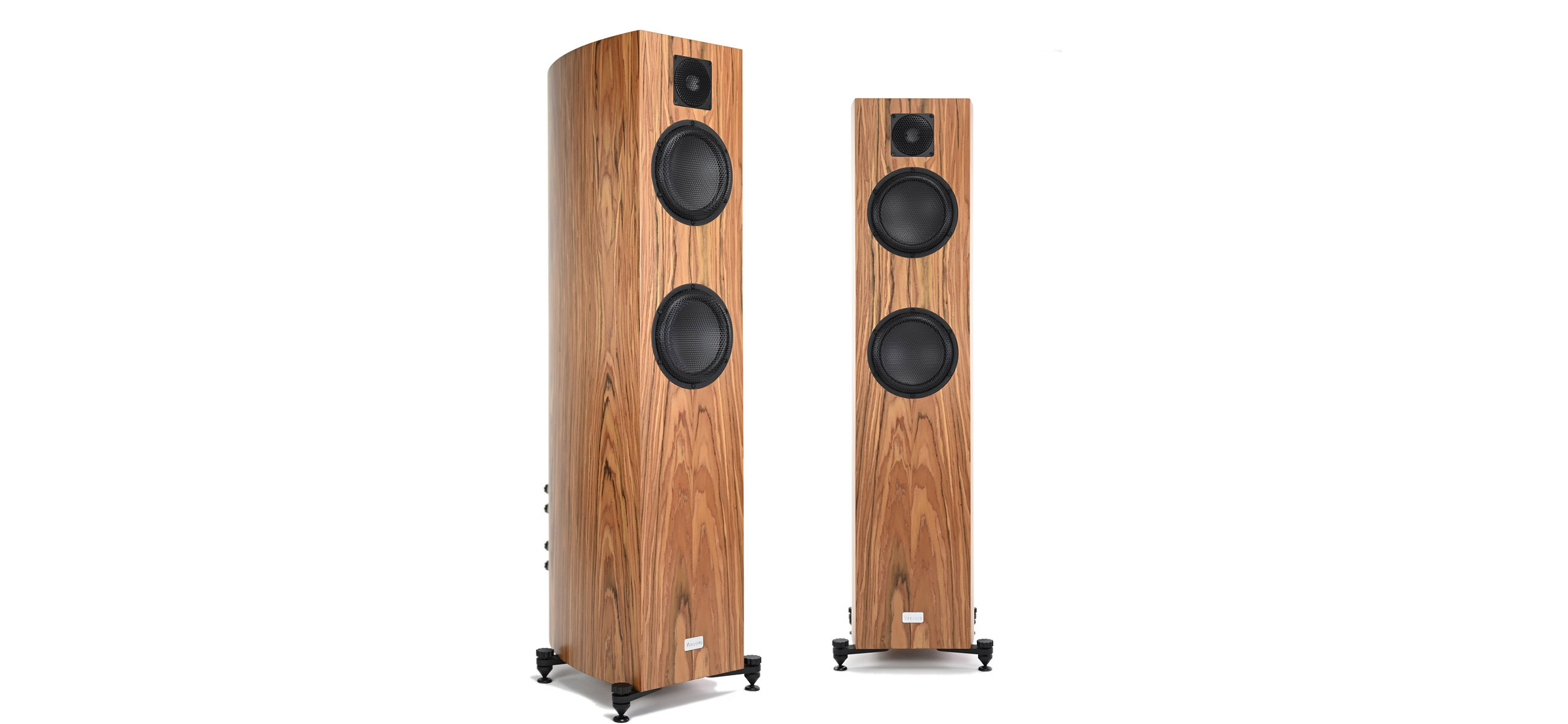
Like all GAUDER AKUSTIK series, the legendary KERAMIK series has been developed, designed and equipped with first-class components on the basis of physical and technical principles. With a live-like and true-to-the-original reproduction, these classics among loudspeakers convey one thing above all: the pure joy of music.
Awarded many national and international prizes.
In addition to the new look, the Black Edition offers completely new technology inside.
The overall package with the extras included in the price is crisply calculated.
You can find an overview of all models here
Choose between the standard ceramic tweeter and (at extra cost) the world's best tweeter, the famous Accuton diamond tweeter. Retrofitting is also possible at any time later.
Equipped with the world's best connection terminals from the German world market leader WBT, our BiWiring terminal allows separate control of the bass and mid-treble ranges.
Instead of the standard spikes with screwed-on bases, the solid aluminium spikes can be screwed on at the bottom with metal screws. The spikes running in them can be easily adjusted from above and improve stability and low bass range.
Once again, the shape of our enclosures is determined by physics. When the wavelengths of a sound wave come within the size of the enclosure, the waves are focused, diffracted or reflected. The drop shape has been shown in many computer calculations to be by far the most favourable shape.
By plugging in the bass extension bridge, the low bass is boosted by 4 dB between 30 Hz and 60 Hz. Adjust the bass volume of the Vescova and Cassiano directly to your listening room! Possible in three steps: -1.5 dB, linear, +1.5 dB
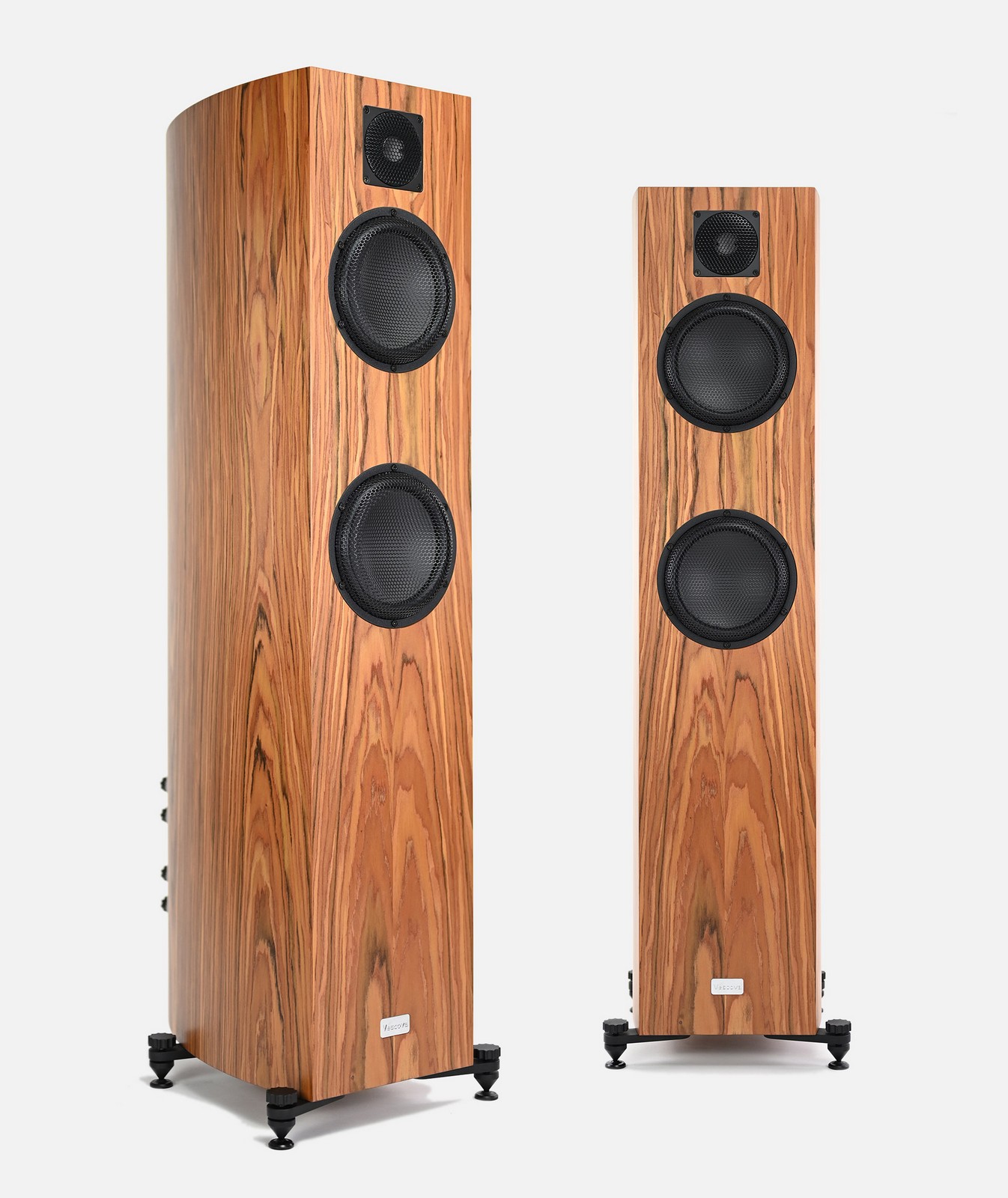
Ceramic - the material of the 21st century. Virtually unrivalled even for loudspeaker cones. That's why, of course, we also use it for the ceramic series. At least up to 1,000 Hz. Because after that, there is something even better: diamond, a material with surprising and amazing properties. Diamond is the material with the greatest hardness (hardness 10).
A diamond diaphragm therefore behaves like an ideal piston even at much higher frequencies. This membrane can also withstand greater accelerations. The resolution of individual tones and impulses is unique. Even the smallest subtleties and details are still audible. Dynamic compression due to deformation is no longer possible. In addition, diamond is the material with the highest sound velocity of all materials (18,000 m/s), which is three times higher than titanium. This means that the feared partial vibrations within the membrane only occur at ultrasonic frequencies that are inaudible to humans. The diamond acts like a huge heat sink, as its thermal conductivity exceeds even that of the second best material, silver, by more than five times! So there can be no more effective cooling of the voice coil. The dynamic compression that often occurred in the past due to the heating of the voice coil and the resulting increase in resistance of the voice coil wire are a thing of the past.
So it's no wonder when people talk about diamond as the dream material par excellence. High resolution, full dynamics even during long operation and freedom from discolouration are guaranteed by the material. The best prerequisites for a fantastic loudspeaker!
For the Cassiano and the Vescova you can order diamond tweeters as an option. A subsequent upgrade is possible at any time.
To the upgrade offer
One-way loudspeakers with a full-range chassis can unfortunately only be used to a very limited extent, as the physical conditions for emitting bass and treble at the same time are diametrically opposed. That is why there are multi-way loudspeakers that cleverly divide the 10 octaves audible by humans: Large, heavy bass cones with small magnets, light midrange cones with extra-strong magnets and small, extremely light but hard tweeter cones with strong FeNd magnets.
The important thing here, as with all ensembles, is their interaction. This is controlled by a crossover. A crossover is an electrical circuit consisting of passive components such as coils (inductors), capacitors (capacitances) and ohmic resistors. With their help, the corresponding frequencies are conducted to their suitable loudspeaker chassis. There is only one catch, this separation is unfortunately very imperfect, so that frequency ranges are often radiated by two loudspeaker chassis at the same time. And that is the big problem, because this grinds out many impulses in the music and worsens the dynamics, making music reproduction bland and boring.
The remedy is "steeper" filters that increase the separation strength (keyword: slope). However, such filters are complex and expensive and extremely difficult to calculate. But: There is no alternative!
That's why we only use steep-edged, phase-linear filters with corrected group delay times with slopes of 50 to 60 dB/octave, which is a multiple of conventional filters, in all our loudspeakers.
Our speakers therefore sound very lively, spatial and extremely natural, unlike many others. You can hear this after just a few seconds. Therefore, compare our loudspeakers with your well-known pieces of music and let yourself be convinced by this fine, lively music reproduction.
All speakers in the KERAMIK series have a connection terminal on the back. Equipped with the latest generation of Nextgen connection terminals from WBT in Essen. With its product know-how and innovative spirit, WBT is one of the world's recognised manufacturers of particularly high-quality connectors. WBT Nextgen binding posts not only provide an excellent mechanical connection to the loudspeaker cable, but also offer outstanding results in terms of sound quality. In our own listening tests, we have also been able to confirm the exceptional sound quality of these connection sockets time and again.
The WBT-Nextgen sockets accept conventional banana plugs from behind, but you can of course also screw on large cable lugs perfectly from the side. The firm hold and the large contact surface guarantee perfect current transmission of the amplifier.
Highly efficient room equaliser
The downward-firing, rounded bass reflex tube ensures even room excitation. Adjustable spikes and our unique room equaliser provide deep bass, a secure stand and the ability to tailor the bass to your listening tastes. Depending on room size and location, you can leave the bass linear, turn it down (-1.5 dB) or turn it up (+1.5 dB).
In the filter theory of electrical engineering, circuits that influence the frequency response are also called electrical filters. In a loudspeaker, the electrical filters are partial filters of an entire acoustic transmission system. In addition to the electrical filters, there are also mechanical and acoustic filters. In its entirety, this results in an acoustic filter that describes the characteristics of a loudspeaker in its entirety, i.e. what we call frequency response, phase response and time response (impulse response).
Filters have different blocking effects and efficiencies depending on how elaborately they are constructed. The simplest loudspeaker filter is the closed box with a blocking effect of 12 dB/octave. This is called a 2nd order filter because each order causes a slope of the blocking effect of 6 dB/octave. Since a bass reflex speaker has two oscillating mass-spring systems (speaker cone and oscillating air column in the tube), the bass reflex system is a 4th order filter system with a blocking effect downwards of 24 dB/octave and an increased efficiency in the bass range. It is therefore very popular and effective. Because a bass reflex speaker has an enclosure opening, enclosure air resonances can be excited by the diaphragm, which are radiated outwards through the tube and cause severe sound colouration, especially in the midrange.
In two-way systems this can be a serious problem. For a two-way system, it is therefore advisable to increase the filter order with electrical filters. For example, a 1st order electrical high-pass filter, if properly sized, can extend the bass range downwards by more than half an octave, which will certainly give a small bookshelf speaker a strong foundation. A 2nd order electrical filter even causes a bass extension of almost a whole octave, making a subwoofer superfluous. In addition, such electrical high-pass filters increase the impedance at the very bottom of the low bass range (1 Hz -20 Hz), thus sparing the chassis extreme excursions if the recording is overloaded with subsonic components or extreme low bass. A shelf speaker is not designed for this. Such electrical filters have astonishing effects in combination with bass speakers, which is why we don't want to do without them. Of course, one thing is clear: the law of conservation of energy in physics also applies here. The low bass extension is bought by a reduction of the impedance in the range 25 Hz - 35 Hz, whereby the speaker draws more current (energy) from the amplifier to fill up the bass range.
For larger tube amplifiers, transistor amplifiers or switching amplifiers this is generally not a problem, unless you want to listen extremely loud. Smaller tube amplifiers, on the other hand, can run out of steam. You can then deactivate the high-pass filtering by pulling the bass extension jumper. This increases the impedance and the required energy is significantly lower. And so you can also operate our loudspeaker cabinets with a smaller tube amplifier.
A sophisticated, multi-layer construction provides the necessary rigidity and almost completely eliminates natural resonances. A flexible, cross-laminated bent plywood panel forms the inner layer. This is followed by an MDF board (medium-density fibreboard) with slots running through it from bottom to top and the actual cabinet. In this way, the cabinet hardness and sound insulation gradually increase towards the outside.
The slots in the MDF panel running from top to bottom in the enclosure wall are filled with fine-grained quartz sand before the lid is inserted. This 8 kg sand filling gives the enclosure additional sound absorption. In addition, two stiffening ribs reinforce the longitudinal structure of the enclosure and effectively prevent the enclosure walls from vibrating as a whole.
Your room is booming? Determine the droning frequency with our Gauder Akustik CD and we will build a de-droning filter into your Gauder Akustik loudspeaker box, which you can activate by means of a jumper.
Due to its geometry, every living room has fixed eigenmodes, so-called room resonances. Due to their long reverberation, they produce a very unpleasant, annoying droning noise that permanently disturbs the enjoyment of music.
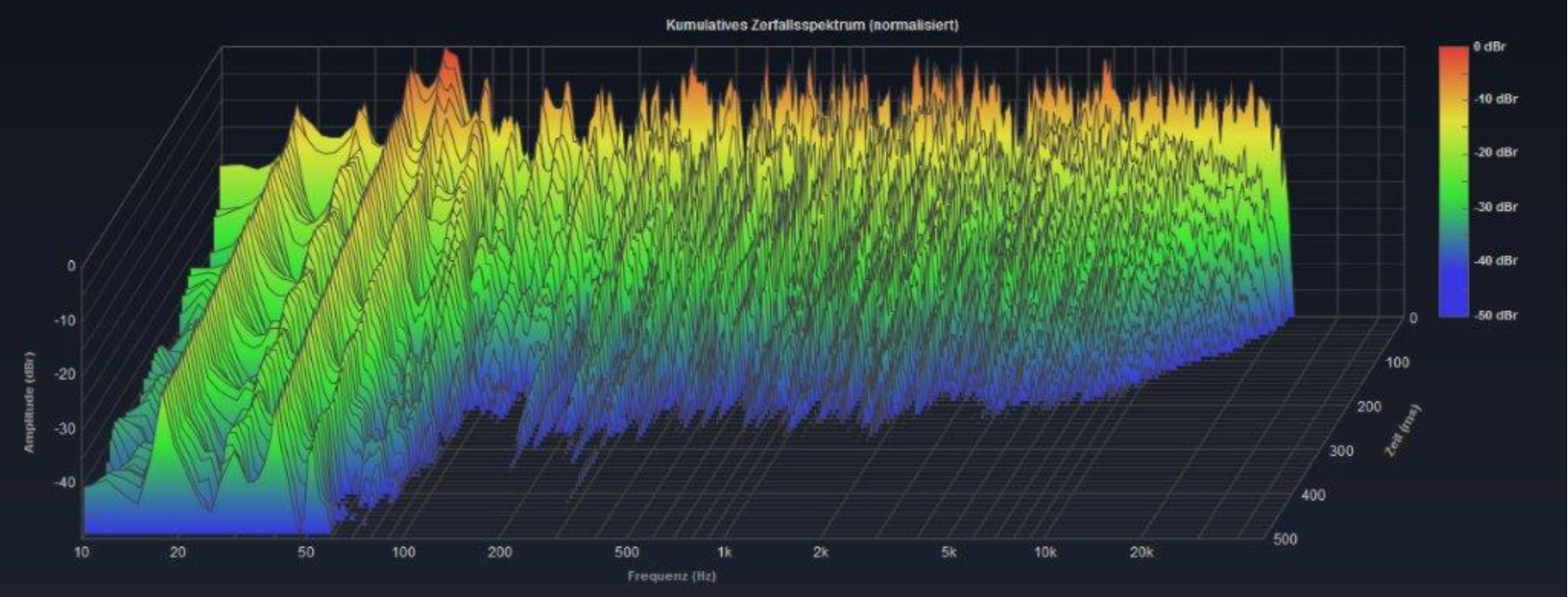
This is what a typical waterfall diagram of a living room looks like. Note how long the 50 Hz room resonance resonates and how much energy it carries.
We build a custom-made filter into your Gauder Akustik loudspeaker cabinet that suppresses these resonances and thus linearises the bass impression. This way, you can finally listen to low bass without an annoying drone. A completely new listening experience opens up!
Our filter works directly in the speaker cabinet, i.e. analogue. Digital filtering by a DSP is much worse in terms of sound, because the entire music signal is digitised and subjected to the filter raking procedure. This always leads to digital errors such as jitter, rounding and calculation errors. Afterwards, the entire signal still has to pass through the digital-to-analogue converter, which leads to further time, phase and frequency response errors. Therefore, an analogue filter in the loudspeaker is generally preferable.
In order to be able to see for yourself how this filter, which we have built in for you, works, we install an additional activation bridge at the back or bottom of the loudspeaker. By pulling the bridge plug, you deactivate the filter. In this way, you can now compare your Gauder acoustic speaker with and without the special filter and thus see how outstandingly the filter improves the reproduction.

Cassiano MK II

04/16
Cassiano MK II

11/15
Vescova MK II
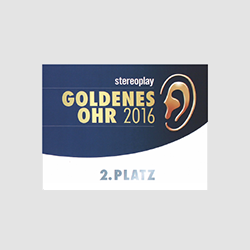
2016
Vescova MK II

06/14
Vescova D
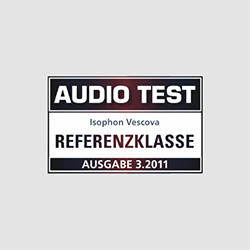
03/11
Vescova

01/18 Vescova
Black Edition

3/22 Cassiano
Final Edition
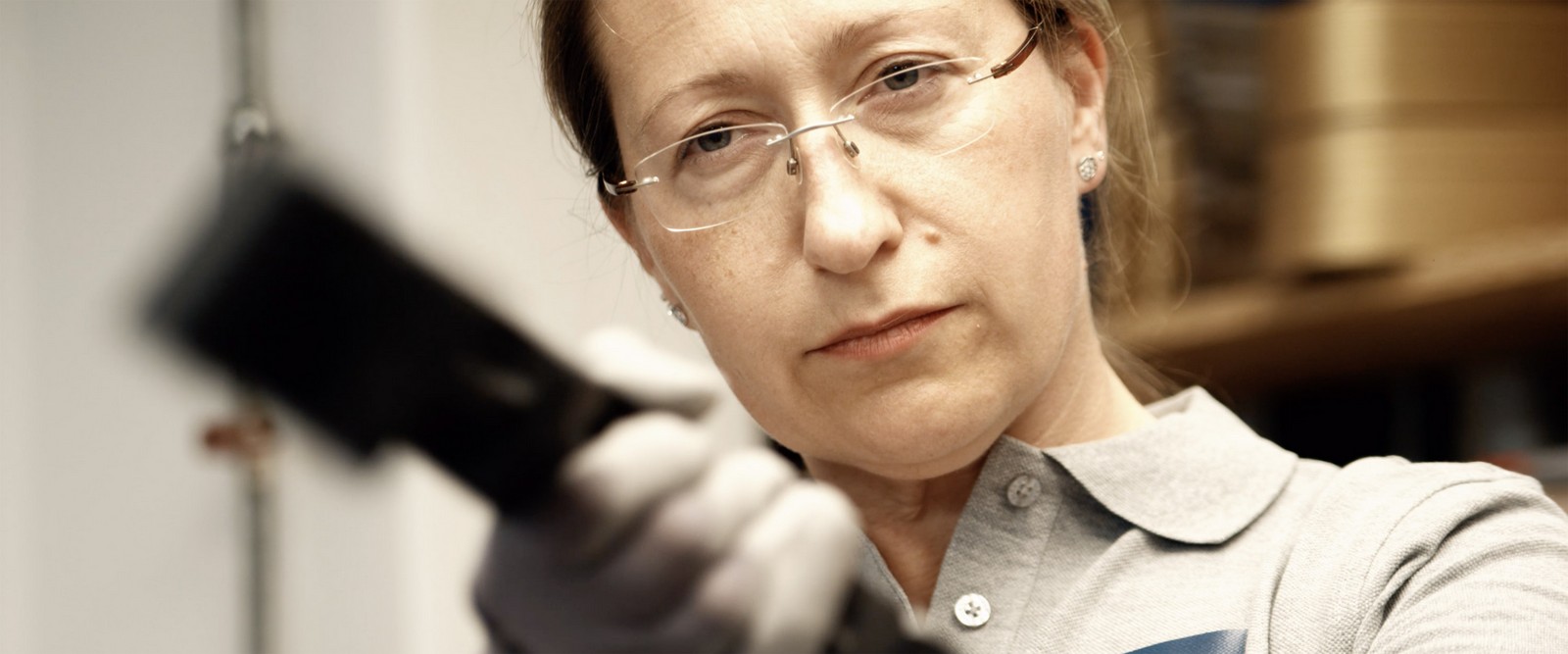
From development and production to the final inspection with listening test - every loudspeaker is manufactured in Renningen.

With our unique GAUDER Lifetime-Update your loudspeaker will always be technically and sonically up to date.
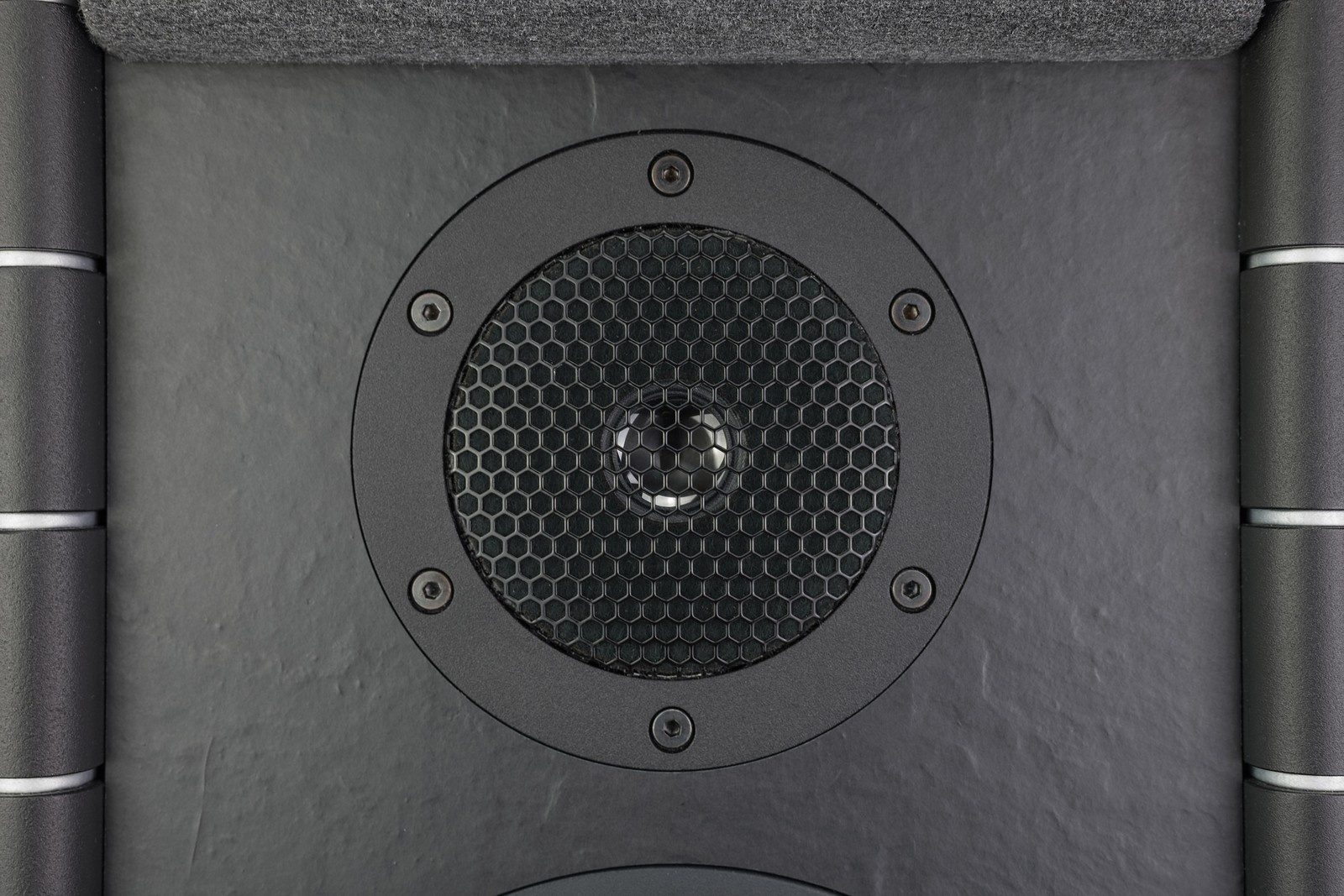
Upgrade possible at any time (BERLINA, DARC, CERAMIC). The surcharge is no higher than at the time of purchase.
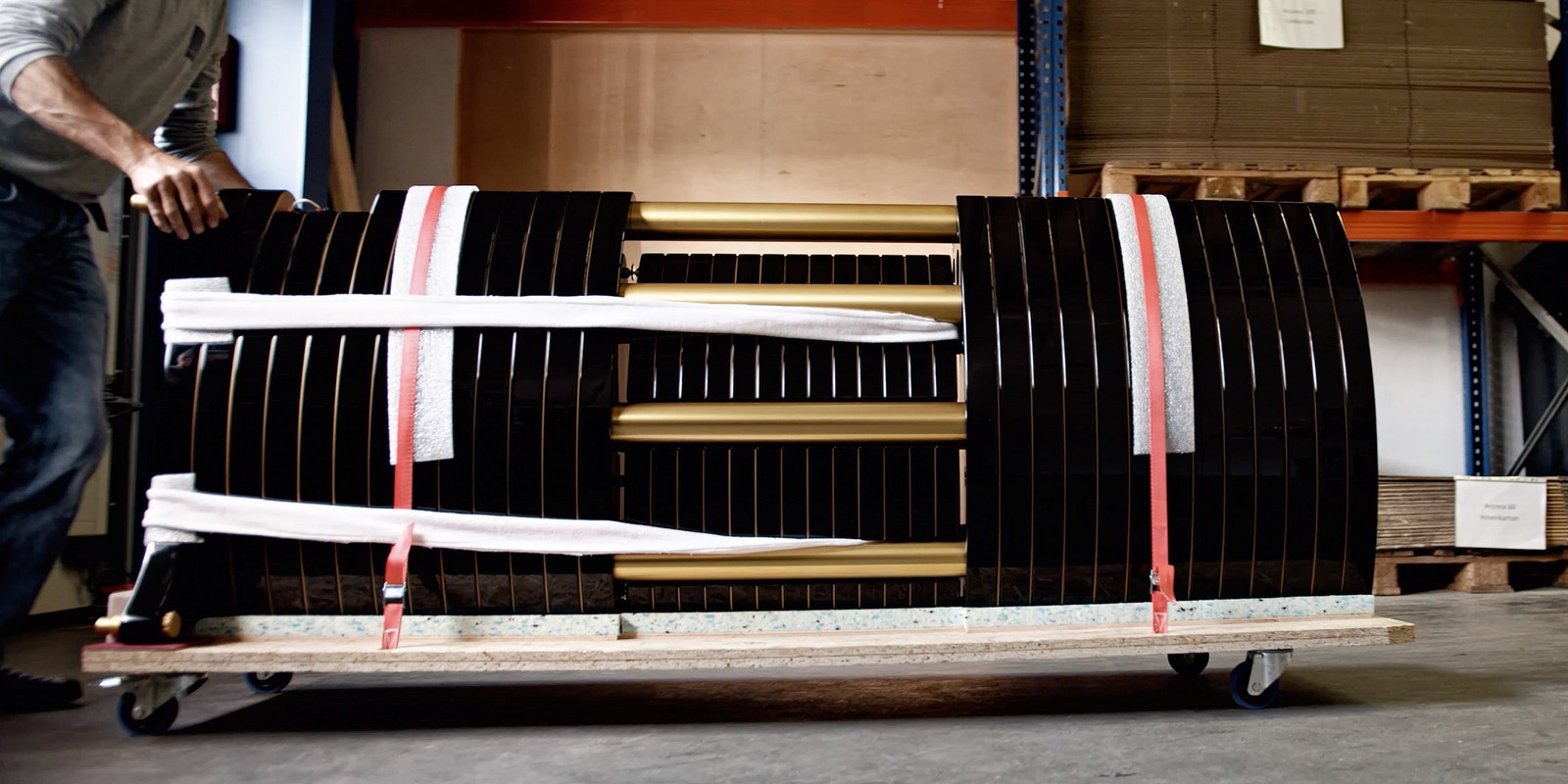
We know about the quality of our speakers. Therefore we grant for registered loudspeakers
10 years warranty.
Would you like more information about our speakers? Would you like to visit our factory or test a loudspeaker?
Please feel free to call us (phone +49 7159 920161) or send us this contact form. We will get back to you as soon as possible.
YOUR GAUDER ACOUSTICS TEAM


